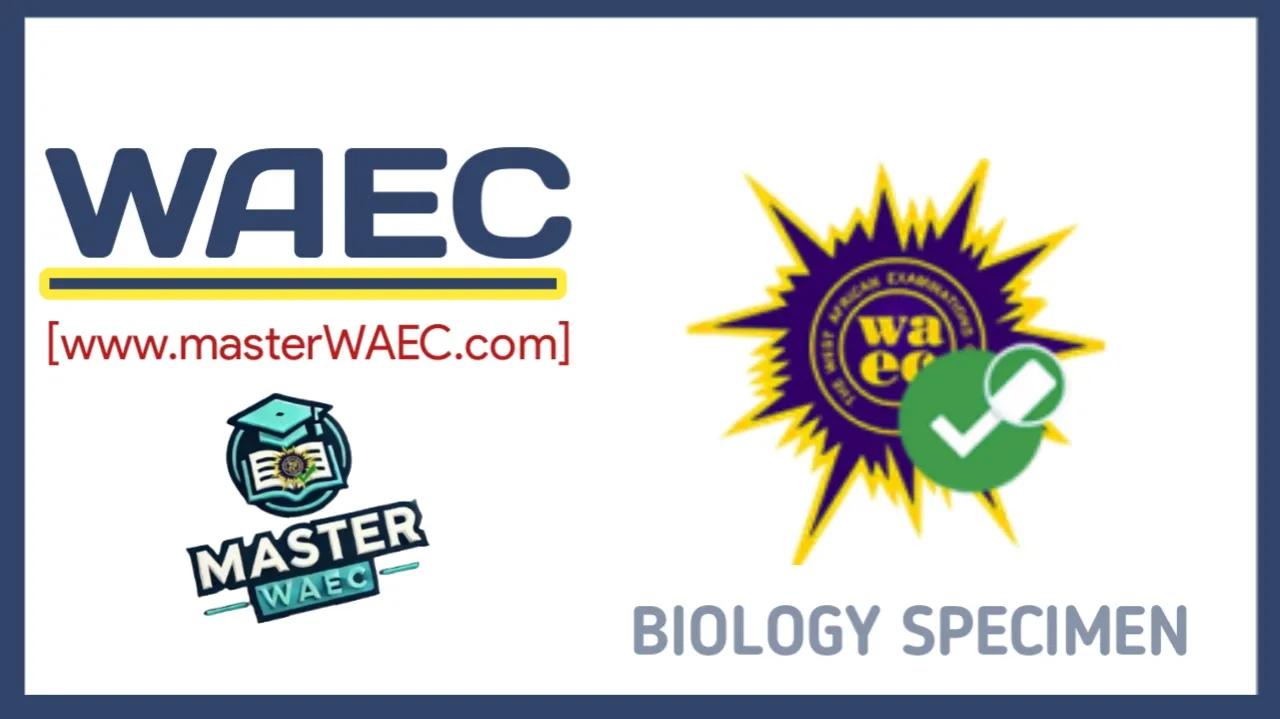Are you writing the upcoming waec biology exam and searching for the biology specimen for waec 2025? If yes, i will like to welcome you to masterwaec.com where we shared with you the verified Biology Specimen for WAEC 2025 and what to expect in your waec biology practical examination 2025.
The west african examination council (WAEC) has officially released the biology Specimen for WAEC 2025 examination. In this blog post, we have also provided you some features, similarities and likely questions and answers to expect under each specimen.
Biology Specimen for WAEC 2025
Below are the complete specimens for waec biology 2025 examination:
- Specimen A – Bean weevil
- Specimen B – Bean seeds (with holes)
- Specimen C – Waterleaf plant (whole)
- Specimen D – Quill feather of a domestic fowl
- Specimen E – Pineapple fruit (longitudinal section)
- Specimen F – Orange fruit (transverse section)
- Specimen G – Raw egg of a domestic fowl (freshly procured with shell intact)
- Specimen H – Test tube containing 3 ml of water (placed on a test tube rack)
- Specimen J – Longitudinal section of boiled egg (with shell)




Specimens and Their Functions
Specimen A – Bean Weevil
The bean weevil is a small insect that damages stored beans by laying eggs in them. The larvae bore holes into the seeds. Function: Used to teach students about pest infestation and the effects of insects on stored food.
Specimen B – Bean Seeds (with holes)
These are bean seeds that have been attacked by pests like the bean weevil. Function: Helps students observe the damage caused by pests and understand food storage methods.
Specimen C – Waterleaf Plant (Whole)
This is a soft vegetable common in Nigeria, known for its juicy leaves and stems. Function: Used to teach students about plant parts and their functions (leaves, stem, roots).
Specimen D – Quill Feather of a Domestic Fowl
The quill is the stiff, hollow part of a bird’s feather. Function: Shows the structure of feathers and how birds are adapted for flight and insulation.
Specimen E – Pineapple Fruit (Longitudinal Section)
A vertical cut of a pineapple showing internal parts like skin, pulp, and core. Function: Helps students study the structure of fruits and identify parts like pericarp and seeds.
Specimen F – Orange Fruit (Transverse Section)
A horizontal slice across an orange showing segments and juice vesicles. Function: Teaches about fruit morphology and seed distribution.
Specimen G – Raw Egg of a Domestic Fowl (with Shell)
A fresh, uncooked egg, still in its shell. Function: Used to study the parts of an egg (shell, albumen, yolk, chalazae) and reproductive structures.
Specimen H – Test Tube Containing 3 ml of Water
A small glass tube with a little amount of water placed in a test tube rack. Function: Used for various practical activities like heating or mixing with chemicals for experiments.
Specimen J – Longitudinal Section of Boiled Egg (with Shell)
A boiled egg cut lengthwise to show inside structures. Function: Helps students observe the effects of heat on animal protein and identify internal egg parts.
Materials and Their Functions
1. Hand Lens/Magnifying Lens
Used to view small specimens (like insects) more clearly by magnifying them.
2. Beaker
A container for holding, mixing, or heating liquids during experiments.
3. Plastic Syringe (Without Needle)
For measuring or transferring liquids in small amounts.
4. Sodium Hydroxide
A chemical used in food tests, especially for testing proteins (Biuret test).
5. 1% Copper Sulphate Solution
Also used in the Biuret test to detect protein in food.
6. Scalpel
A small, sharp knife used for cutting specimens like fruits or animal parts.
7. Test Tube
A glass container for mixing or heating small quantities of chemicals.
8. Test Tube Rack
A stand for holding test tubes upright and safe during experiments.
9. Bunsen Burner
Provides heat for experiments like boiling or heating chemicals.
NB:
1. All specimens can be provided as group specimens for five (5) to ten (10) candidates.
2. All specimens must carry individual labels (e.g. A, B, C, D, E, F, G, H, and J).
3. Pictures and drawings of specimens are not to be supplied unless they are among the list of specimens.
Biology Specimen for WAEC 2024
| SPECIMEN A | Gill of fish (freshly procure) |
| SPECIMEN B | Whole liver from a domestic fowl with gall bladder attached, in a Petri dish (freshly procured) |
| SPECIMEN C | Lungs from a domestic fowl on a white tile (freshly procured) |
| SPECIMEN D | Whole gizzard from a domestic fowl, in a Petri dish (freshly procured) |
| SPECIMEN E | Whole intestine from a domestic fowl spread in a tray (freshly procured) |
| SPECIMEN F | Ginger rhizome (fresh) |
| SPECIMEN G | Onion bulb |
| SPECIMEN H | Leaf of Bryophyllum (with adventitious roots) |
| SPECIMEN J | Cassava stem |
| SPECIMEN K | Cassava tuber |
| SPECIMEN L | Thoracic vertebra |
| SPECIMEN M | Humerus bone |
| SPECIMEN N | Mango seed (dry) |
| SPECIMEN P | Femur bone |
| SPECIMEN Q | Lumbar vertebra |
| SPECIMEN R | Orange seeds (dry) |
ALSO READ: WAEC Syllabus for Biology 2025
Biology Specimen for WAEC 2025
Specimen A: Gill of fish (freshly procured).
The gill is an essential respiratory organ in fish, enabling them to extract oxygen from water and expel carbon dioxide. It consists of delicate, feathery filaments that provide a large surface area for efficient gas exchange. Water flows over the gill filaments, and oxygen diffuses into the bloodstream while carbon dioxide is released. This adaptation allows fish to survive and function effectively in their aquatic habitat.
FEATURES:
• Thin filaments
• Absorbs oxygen from water
• Releases carbon dioxide
FUNCTIONS:
• Respiration
• Gas exchange
• Allows fish to thrive in aquatic environments
Specimen B: Whole liver from a domestic fowl with gall bladder attached, in a Petri dish (freshly procured)
The liver is a crucial organ in a domestic fowl, playing a key role in detoxification, metabolism, and energy storage. It produces bile, which is temporarily stored in the gall bladder before being released into the digestive system to aid in the breakdown and absorption of fats.
Additionally, the liver helps in filtering toxins from the blood, storing essential nutrients, and regulating metabolic processes, making it one of the most important organs in the body.
FEATURES:
• Vital organ
• Produces bile
• Filters toxins from blood
• Stores energy and nutrients
FUNCTIONS:
• Detoxification
• Metabolism
• Energy storage
• Aids in fat absorption
Specimen C: Lungs from a domestic fowl on a white tile (freshly procured)
The lungs of a domestic fowl are essential respiratory organs responsible for gas exchange. Unlike mammals, bird lungs are compact and connected to air sacs that ensure a continuous flow of oxygen. Oxygen is absorbed into the bloodstream while carbon dioxide is expelled. The lungs contain tiny air capillaries instead of alveoli, allowing efficient gas exchange. This specialized respiratory system enables birds to sustain high energy levels needed for activities like flying.
FEATURES:
• Made up of tiny air sacs (alveoli)
• Exchanges oxygen and carbon dioxide
• Essential for gas exchange
FUNCTIONS:
dioxideSpecime
• Respiration
• Gas exchange
• Brings oxygen into the body
• Removes carbon dioxide
Specimen D: Whole gizzard from a domestic fowl, in a Petri dish (freshly procured)
The gizzard is a thick, muscular organ in birds that plays a crucial role in digestion by grinding food into smaller particles. Since birds lack teeth, the gizzard uses its strong muscles and tough inner lining to break down tough plant materials and grains. In many birds, small stones or grit are swallowed and stored in the gizzard to aid in the grinding process. This adaptation allows birds to efficiently digest a wide variety of food sources.
FEATURES:
• Muscular organ
• Grinds food in digestive process
• Breaks down tough plant material
FUNCTIONS:
• Digestion
• Breaks down food
• Absorbs nutrients
Specimen E: Whole intestine from a domestic fowl spread in a tray (freshly procured)
The intestine is a crucial organ in the digestive system of a domestic fowl, responsible for absorbing nutrients from digested food. It is a long, coiled tube lined with numerous finger-like projections called villi, which increase the surface area for efficient absorption of nutrients into the bloodstream. The intestine is divided into the small and large intestines, each playing a role in digestion and waste elimination. This organ ensures that the bird obtains the necessary nutrients for growth, energy, and overall survival.
FEATURES:
• Long, thin tube
• Finger-like projections (villi)
• Absorbs nutrients from food
FUNCTIONS:
• Digestion
• Absorbs nutrients
• Essential for survival
Specimen F: Ginger rhizome (fresh)
Ginger is a flowering plant known for its spicy, aromatic rhizome, which is widely used in cooking and traditional medicine. The rhizome is an underground stem that stores nutrients and produces new shoots and roots, allowing the plant to grow and spread. Ginger has been valued for centuries for its medicinal properties, including relieving nausea, reducing inflammation, and aiding digestion. Its adaptability and health benefits make it an important plant in both culinary and medicinal applications.
FEATURES:
• Underground stem
• Produces new shoots and roots
• Spicy, edible root
FUNCTIONS:
• Reproduction
• Medicinal properties
• Relieves nausea and pain
Specimen G: Onion bulb
The onion is a plant with a bulbous underground storage organ that serves as a food reserve for the plant. The bulb consists of multiple layers of fleshy scales, which store energy and nutrients needed for growth. Onions are widely used in cooking due to their strong flavor and aroma, making them a staple ingredient in many cuisines around the world. Besides culinary uses, onions also have medicinal properties, including antibacterial and antioxidant benefits.
FEATURES:
• Bulbous underground storage organ
• Layers of cells store energy and nutrients
• Edible
FUNCTIONS:
• Food source
• Stores energy and nutrients
• Adds flavor and texture to dishes
Specimen H: Leaf of Bryophyllum (with adventitious roots)
Bryophyllum is a unique plant known for its ability to reproduce vegetatively through its leaves. Small plantlets with adventitious roots develop along the edges of the leaf, eventually detaching and growing into new plants. This adaptation allows Bryophyllum to reproduce rapidly and thrive in various environments without relying on seeds. Its efficient propagation method makes it a resilient and successful species in nature.
FEATURES:
• Adventitious roots form on leaves
• Reproduces quickly and efficiently
• Successful species in many environments
FUNCTIONS:
• Reproduction
• Adaptation
• Allows plant to thrive in various environments
Specimen J: Cassava stem
The cassava plant is a tropical crop widely cultivated for its starchy root, which serves as a major food source. The stem is tough and fibrous, providing structural support for the plant. It also plays a crucial role in vegetative propagation, as cassava is commonly grown from stem cuttings rather than seeds. This hardy plant is an essential staple in many communities, offering a reliable source of carbohydrates and essential nutrients for human consumption.
FEATURES:
• Tough, fibrous material
• Provides support and structure
• Starchy root used as food source
FUNCTIONS:
• Support and structure
• Food source
• Provides energy and nutrients
Specimen K: Cassava tuber
The cassava tuber is the edible, starchy root of the cassava plant, serving as a major source of carbohydrates. It has a white or yellowish flesh that is rich in energy but low in protein. Cassava is a staple food in many tropical regions, where it is processed into various forms such as garri, fufu, and tapioca. Despite its high carbohydrate content, proper processing is necessary to remove naturally occurring toxins before consumption.
FEATURES:
• Starchy, edible root
• High in carbohydrates, low in protein
• Staple food for many people
FUNCTIONS:
• Food source
• Provides energy and nutrients
• Essential for survival
Specimen L: Thoracic vertebra
The thoracic vertebra is a type of vertebral bone found in the chest region of the spine. It consists of a vertebral body, pedicles, and transverse processes, which provide structural support and attachment points for ribs. This bone plays a crucial role in protecting the spinal cord while also allowing for limited flexibility and movement of the upper body. As part of the skeletal system, the thoracic vertebra helps maintain posture and supports the body’s weight.
FEATURES:
• Body, pedicles, transverse processes, and spinous process
• Provides support and protection for spinal cord
• Allows for flexibility and movement
FUNCTIONS:
• Support and protection
– Flexibility and movement
– Essential for spinal column
Specimen M: Humerus bone
The humerus is the long bone of the upper arm, connecting the shoulder to the elbow. It consists of a shaft, a rounded head that fits into the shoulder joint, and condyles at the lower end that articulate with the forearm bones. The humerus provides structural support, serves as an attachment site for muscles and ligaments, and plays a vital role in arm movement and flexibility. It is essential for various motions, including lifting, rotating, and bending the arm.
FEATURES:
• Long bone of upper arm
• Shaft, head, and condyles
• Provides support and attachment points for muscles and ligaments
FUNCTIONS:
• Support and attachment points
• Allows for movement and flexibility
• Essential for skeletal system
Specimen N: Mango seed (dry)
The mango seed is the reproductive structure of the mango plant, enclosed within a hard, woody coat that protects the single embryo inside. It plays a crucial role in the plant’s life cycle, enabling reproduction and dispersal. Under suitable conditions, the seed germinates to produce a new mango plant. Mango seeds are also known for their medicinal and nutritional properties, as they contain beneficial compounds used in traditional remedies.
FEATURES:
• Hard, woody coat
• Single embryo
• Reproductive structure
FUNCTIONS:
• Reproduction
• Allows mango plant to reproduce and spread
• Essential for life cycle
Specimen P: Femur bone
The femur is the longest and strongest bone in the human body, located in the thigh. It consists of a shaft, a rounded head that fits into the hip joint, and condyles at the lower end that articulate with the knee joint. The femur provides structural support, serves as an attachment site for muscles and ligaments, and plays a crucial role in movement, weight-bearing, and flexibility of the leg. Its strength enables stability and mobility in walking, running, and other physical activities.
FEATURES:
• Long bone of thigh
• Shaft, head, and condyles
• Provides support and attachment points for muscles and ligaments
FUNCTIONS:
• Support and attachment points
• Allows for movement and flexibility
• Essential for skeletal system
Specimen Q: Lumbar vertebra
The lumbar vertebra is a bone in the lower back region of the spine, designed to support body weight and provide flexibility. It consists of a large vertebral body, pedicles, transverse processes, and a spinous process, all of which contribute to spinal stability and movement. The lumbar vertebra plays a crucial role in protecting the spinal cord, allowing for bending and twisting motions, and serving as an attachment site for muscles and ligaments that support posture and movement.
FEATURES:
• Body, pedicles, transverse processes, and spinous process
• Provides support and protection for spinal cord
• Allows for flexibility and movement
FUNCTIONS:
• Support and Functions
• Flexibility and movement
• Essential for spinal column
• Bears weight of body
• Provides attachment points for muscles and ligaments
Specimen R: Orange seeds (dry)
- Group Specimen: Orange seeds (dry) can be provided as a group specimen for 5-10 candidates, allowing multiple students to observe and study the specimen simultaneously.
- Individual Labels: Each specimen, including the Orange seeds (dry), must carry an individual label (e.g., R) to identify it clearly.
This labeling system ensures that each specimen is easily recognizable and distinguishable from others.
- Biology specimen for waec 2025
- WAEC biology practical specimen 2025
- WAEC biology specimen 2025
These are the complete biology practical specimens for waec 2025, if you have question related to any of the above mentioned specimen, feel free to drop a comment below

Kolade Kayode, known as Mr. KK, I am a Nigerian education blogger and founder of MasterWAEC.com. Passionate about student success, I simplifies WAEC exam preparation with accurate tips and resources to help students excel.


3 thoughts on “Biology Specimen for WAEC 2025”